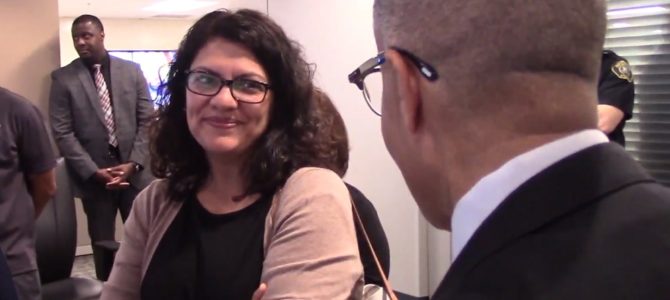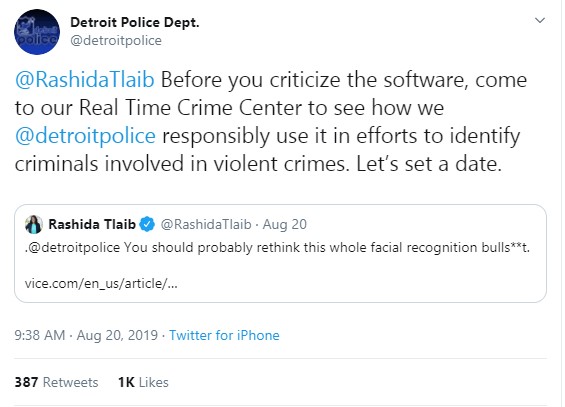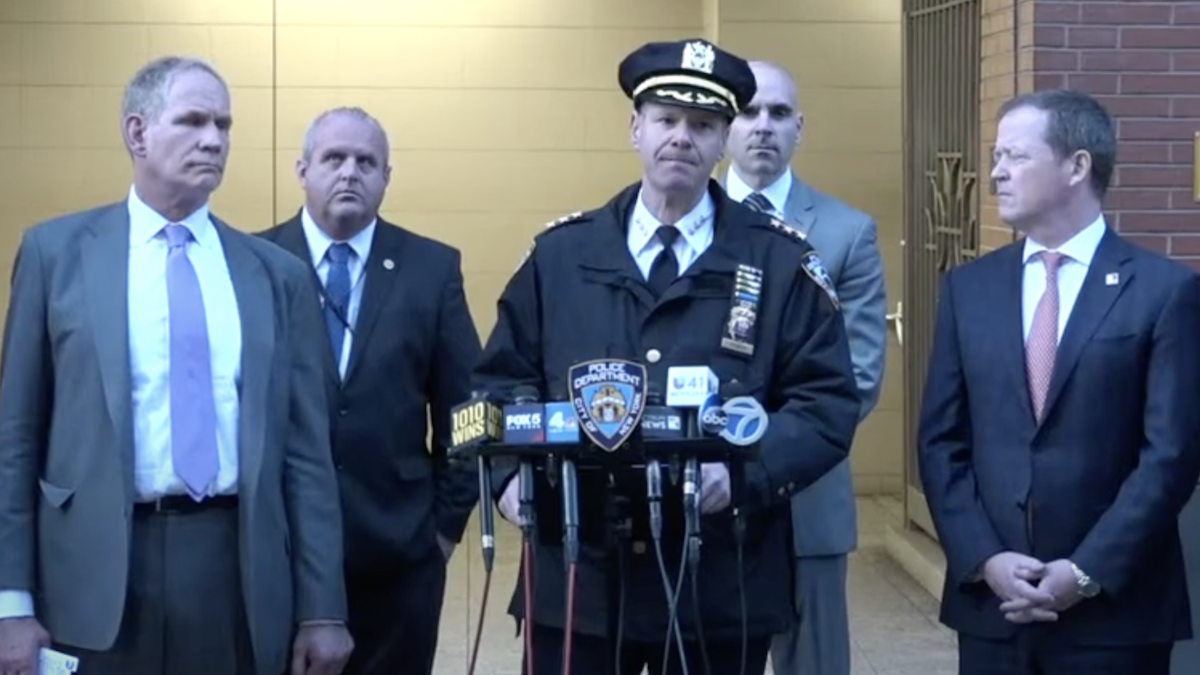
Critics from across the political spectrum are wary of the Detroit Police Department’s (DPD) use of facial recognition software to curb violent crime. Their concerns range from whether the technology violates the First, Fourth and Fourteenth Amendments, if and by what factor a largely unmonitored surveillance system successfully deters crime, and the known shortcomings in facial detection algorithms’ ability to identify the faces of African-American people, particularly women.
When freshman Rep. Rashida Tlaib, D-Mich., who represents portions of Detroit, visited the DPD’s Real Time Crime Center, she cited a different concern. “Analysts need to be African Americans,” Tlaib told Detroit’s police chief, James Craig. “Not people that are not. I think non-African Americans think African Americans all look the same.”
From a woman who has been quick to accuse opponents of racism, the remarks were shocking. Even more unbelievable was Tlaib’s Friday Detroit News op-ed, in which she alleged her words “weren’t racist.”
The representative’s comment referenced a phenomenon known as the cross-race effect, which supposes people identify members of their own race more accurately than they do members of other races. Detroit’s population is about 80 percent African American. Citing the cross-race effect in her demand that the DPD hire all African Americans analysts implies Tlaib believes African Americans commit 100 percent of violent crime in the city.
Speaking to the Detroit News about the representative’s “insulting” comments, which he said left both black and white analysts “outraged,” Craig provided an alternative interpretation. “To say people should be barred from working somewhere because of their skin color? That’s racist.”
Attacking Before She Knows Anything
Tlaib’s tense visit to the Real Time Crime Center occurred on the heels of inappropriate and acrimonious online jabbing. On August 20, Tlaib tweeted that the DPD “should probably rethink this whole facial recognition bulls**t.” Using foul language to cover a lack of content is nothing new for Tlaib, who is preparing for her next campaign by selling apparel splashed with her uncouth rallying cry of “impeach the mother-cker.”
The DPD responded by inviting Tlaib to the center to witness how the department “responsibly use[s] [technology] in efforts to identify criminals involved in violent crimes.”

Setting the tone for her September 30 visit, Tlaib asked a Detroit News reporter taping the meeting if he was “facial recognizing [her] right now.”
Afterwards, Craig gave the representative a crash course on how his department’s analysts use the software to apprehend violent criminals. In the Detroit News video of the visit, Tlaib often appears unwilling to learn, informing Craig she comes to him “from a place of fully understanding [the issues with facial recognition software].”
Tlaib’s remarks, particularly her racist comments, prove she is far from solidly understanding the shortcomings of facial recognition techniques. She was also disrespectful of the men and women more than 550 Detroit businesses and entities entrust with their safety through Project Green Light.
How Project Green Light Began
Project Green Light began in 2016, after the DPD recognized that 25 percent “of violent crime in the city [occurred] within 500 feet of gas stations.” The DPD partnered initially with eight local gas stations. They installed real-time security cameras and placed green lights outside to signal to patrons and would-be-criminals that DPD monitored their cameras.
In late 2017, the city brought Face Plus facial recognition software to Project Green Light and the Real Time Crime Center. Although the technology is capable of real-time facial analysis, the DPD, according to Craig, does not “monitor innocent people in real time.” Only if there is an “articulable reasonable suspicion that an individual is observed or reported to have committed a crime” will a “still image [be] provided for analysis.”
While long-term studies of Project Green Light’s effects have not been completed, at a press conference in March, Craig stated car-jackings have decreased by 50 percent in three years. Additionally, the city experienced a 45 percent decline in robberies during the first quarter of 2019.
The DPD’s use of facial recognition technology went unmonitored for 18 months before the department settled a privacy policy in July. The policy aimed to ensure facial recognition software would not violate the First, Fourth, or Fourteenth Amendments, does not target specific groups of individuals based on “religious, political or social views,” and does not target individuals based on ethnic background or citizenship status.
Directive 307.5, governing the use of facial recognition technology, was passed in an 8-3 vote by the Detroit Police Board of Commissioners on September 19. In addition to addressing privacy concerns, the nine-page document limits the DPD’s sharing of its technology with outside agencies, identifies individuals responsible for oversight of the facial recognition program, and outlines penalties for those found violating the policy. Importantly, it states that facial recognition matches are “not to be considered a positive identification of any subject,” but rather must be corroborated through thorough investigation.
A number of legitimate areas for concern remain regarding DPD’s facial recognition software use, several enumerated in a June 2019 report on Project Green Light. The report states DPD has supposedly installed “hidden neighborhood cameras” in an effort to find illegal garbage dumpers, notes a sensation confessed by some Detroit business owners that they are “paying for policing,” and alleges the police prioritize Project Green Light locations over non-Project Green Light locations. Additionally, the report cites concerns that Project Green Light may not prove a long-term deterrent to criminals, as locations are only patrolled virtually one time each day.
I Know More about Racism than You, Chief
Tlaib’s visit to the Real Time Crime Center, however, did not focus on legitimate concerns about possible DPD overreach or the effects of Project Green Light. Rather, she seemed intent on ensuring Craig, who began his police career in 1977, benefitted from her expertise.
Tlaib’s frequent interruptions were designed to catch Craig and his department in misbehavior, which came into focus when Craig put his software’s shortcomings on display. Craig demonstrated how it identified an African American male suspect as an African American female. “The computer, not [the analyst]” Craig began to explain, before Tlaib cut him off.
Local Support for Project Green Light
Although murder, assault, rape, and robbery decreased in Detroit from 2017 to 2018, FBI statistics released on September 30 show that, in 2018, Detroit still ranked as the most violent big city in the nation.
In a city of 139 square miles, Project Green Light allows a force of 2,200 officers, whose response times are among the longest in the nation, to better protect Detroit citizens. As shown in a map of Project Green Light locations on the DPD’s website, Detroit’s efforts have found plentiful partners. The city boasted more than 568 Project Green Light locations in July, with an additional 80 businesses “in the pipeline.”
Clement Brown, the owner of several clothing stores in downtown Detroit, the Detroit News reported in March that “thieves drove a truck through the window” of one of his storefronts in 2018. Although Brown initially worried over the cost to join Project Green Light, an upfront fee of $4,000 to $6,000, and an additional $150 per month for video storage, he stated “it’s definitely worth it.”
The Detroit Housing Commission used a federal grant to upgrade bring Project Green Light to a community of elderly and near-elderly Detroit residents in November 2018. At a community meeting attended by Craig and Detroit Mayor Mike Duggan to gauge residents’ interest, an attendee interviewed by the Detroit Free Press said “almost all” of the 50 to 60 residents who attended “were for [Project Green Light].”
Yet, in July, Tlaib sponsored a bill that would prohibit the use of facial recognition software in public housing around the nation. “We cannot allow residents…to be criminalized and marginalized with the use of…facial recognition technology,” Tlaib stated. After her visit to the Real Time Crime Center, Tlaib indicated she still believed it would be “dehumanizing to have surveillance” in public housing.
That Tlaib would disregard the public buy-in of Detroit residents to a program they feel increases their safety is no surprise. The representative has a history of prioritizing her beliefs over her constituents.
The effectiveness of and privacy concerns regarding Project Green Light and the Real Time Crime Center deserve to be thoroughly investigated and addressed, particularly as the DPD prepares to expand the programs. Tlaib’s visit to the DPD made no progress on this score.
Her racist comments prove the representative maintains an ignorance of the algorithmic and human shortcomings that lead to racial bias in facial recognition, or believes that, in Detroit, only people of color commit violent crimes. By doubling down on those comments, and alleging in her Detroit News editorial that the DPD is using “broken technology…to lock up black and brown people in Detroit,” Tlaib shows she took nothing away from her grandstanding visit to the Real Time Crime Center.









